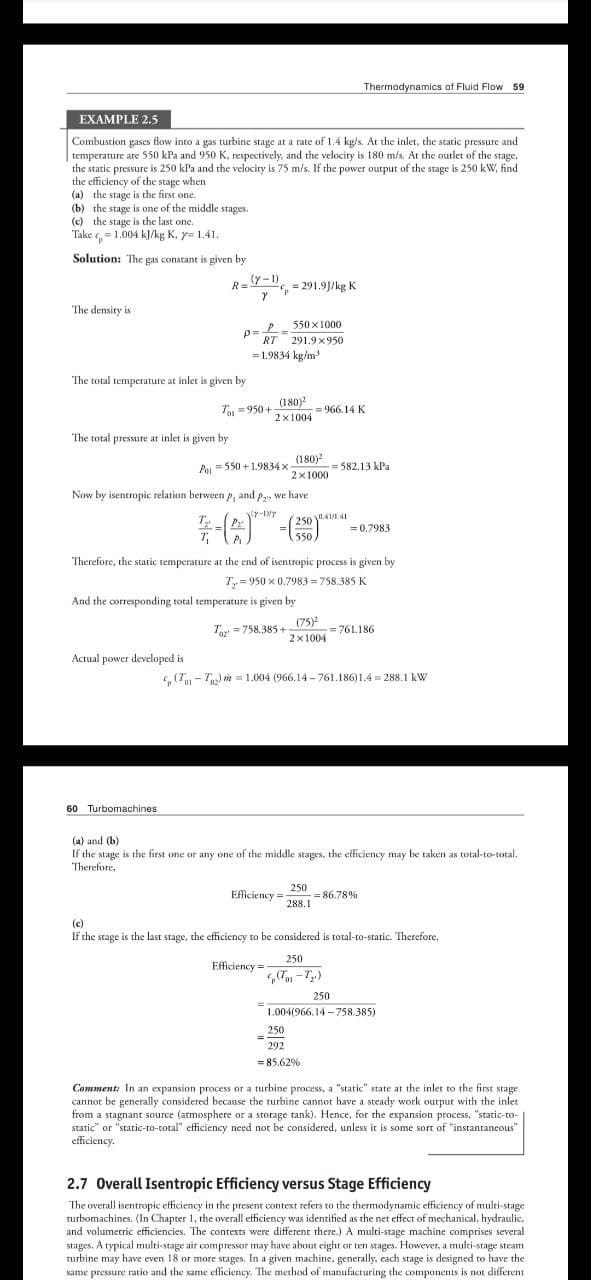Combustion gases flow into a gas turbine stage at a rate of 1.4 kg/s. Ar the inlet, the static pressure and temperature are 550 kPa and 950 K, respectively, and the velocity is 180 m/s. At che outlet of the stage, the static pressure is 250 kPa and the velocity is 75 m/s. If the power oueput of the stage is 250 k W, find the efficiency of the stage when (a) the stage is the first one. (b) the stage is one of the middle stages. (c) the stage is the last one. Take ,- 1.004 kJ/kg K. y= 1.41. %3D
Combustion gases flow into a gas turbine stage at a rate of 1.4 kg/s. Ar the inlet, the static pressure and temperature are 550 kPa and 950 K, respectively, and the velocity is 180 m/s. At che outlet of the stage, the static pressure is 250 kPa and the velocity is 75 m/s. If the power oueput of the stage is 250 k W, find the efficiency of the stage when (a) the stage is the first one. (b) the stage is one of the middle stages. (c) the stage is the last one. Take ,- 1.004 kJ/kg K. y= 1.41. %3D
Elements Of Electromagnetics
7th Edition
ISBN:9780190698614
Author:Sadiku, Matthew N. O.
Publisher:Sadiku, Matthew N. O.
ChapterMA: Math Assessment
Section: Chapter Questions
Problem 1.1MA
Related questions
Question
Here questions and answers both are available I need your handwriting and also please don't copy and paste chegg answers

Transcribed Image Text:Thermodynamics of Fluid Flow 59
EXAMPLE 2.5
Combustion gases flow into a gas turbine stage at a rate of 1,4 kg/s. At the inlet, the static pressure and
temperature are 550 kPa and 950 K, respectively, and the velocity is 180 m/s. At the outlet of the stage,
the static pressure is 250 kla and the velocity is 75 m/s. If the power output of the stage is 250 kW, find
the efficiency of the stage when
(a) the stage is the first one.
(b) the stage is one of the middle stages.
(c) the stage is the last one.
Take ,- 1.004 kJ/kg K, y= 1.41.
Solution: The gas constant is given by
R-7-1 = 291.9J/kg K
The density is
550 x1000
RT
= 1.9834 kg/m
291.9 x950
The total temperature at inlet is given by
(180)
Toi = 950 +
= 966.14 K
2x1004
The total pressure at inlet is given by
(180)
Po =550 +19834 x
= 582.13 kPa
2x1000
Now by isentropic relation between p, and p, we have
ア-INY
T,
250 41.4
= 0.7983
550
Therefore, the static temperature at the end of isentropic process is given by
T= 950 x 0.7983 = 758.385 K
And the corresponding total temperature is given by
(75)
T
= 758.385 +
= 761.186
2x1004
Actual power developed is
(7- T) it = 1.004 (966.14 - 761.186)1.4 = 288.1 kW
60 Turbomachines
(a) and (b)
If the stage is the first one or any one of the middle stages, the efficiency may be taken as total-to-total.
Therefore,
250
Efficiency
=
= 86.78%
288.1
(c)
If the stage is the last stage, the efficiency to be considered is total-to-static. Therefore,
250
Eficiency =
250
1.004(966.14 - 758.385)
250
292
= 85.62%
Comment: In an expansion process or a turbine process, a "static" state at the inlet to the first stage
cannot be generally considered because the turbine cannot have a steady work output with the inlet
from a stagnant source (atmosphere or a storage tank). Hence, for the expansion process, "static-to-
static" or "static-to-total" efficiency need not be considered, unless it is some sort of "instantaneous"
efficiency.
2.7 Overall Isentropic Efficiency versus Stage Efficiency
The overall isentropic efficiency in the present context refers to the thermodynamic efficiency of multi-stage
turbomachines. (In Chapter 1, the overall efficiency was identified as the net effect of mechanical, hydraulic,
and volumetric efficiencies. The contexts were different there.) A multi-stage machine comprises several
stages. A typical multi-stage air compressor may have about eight or ten stages. However, a multi-stage steam
turbine may have even 18 or more stages. In a given machine, generally, each stage is designed to have the
same pressure ratio and the same eficienty. The method of manufacturing the components is not different
Expert Solution
This question has been solved!
Explore an expertly crafted, step-by-step solution for a thorough understanding of key concepts.
This is a popular solution!
Trending now
This is a popular solution!
Step by step
Solved in 3 steps with 2 images

Knowledge Booster
Learn more about
Need a deep-dive on the concept behind this application? Look no further. Learn more about this topic, mechanical-engineering and related others by exploring similar questions and additional content below.Recommended textbooks for you

Elements Of Electromagnetics
Mechanical Engineering
ISBN:
9780190698614
Author:
Sadiku, Matthew N. O.
Publisher:
Oxford University Press

Mechanics of Materials (10th Edition)
Mechanical Engineering
ISBN:
9780134319650
Author:
Russell C. Hibbeler
Publisher:
PEARSON

Thermodynamics: An Engineering Approach
Mechanical Engineering
ISBN:
9781259822674
Author:
Yunus A. Cengel Dr., Michael A. Boles
Publisher:
McGraw-Hill Education

Elements Of Electromagnetics
Mechanical Engineering
ISBN:
9780190698614
Author:
Sadiku, Matthew N. O.
Publisher:
Oxford University Press

Mechanics of Materials (10th Edition)
Mechanical Engineering
ISBN:
9780134319650
Author:
Russell C. Hibbeler
Publisher:
PEARSON

Thermodynamics: An Engineering Approach
Mechanical Engineering
ISBN:
9781259822674
Author:
Yunus A. Cengel Dr., Michael A. Boles
Publisher:
McGraw-Hill Education

Control Systems Engineering
Mechanical Engineering
ISBN:
9781118170519
Author:
Norman S. Nise
Publisher:
WILEY

Mechanics of Materials (MindTap Course List)
Mechanical Engineering
ISBN:
9781337093347
Author:
Barry J. Goodno, James M. Gere
Publisher:
Cengage Learning

Engineering Mechanics: Statics
Mechanical Engineering
ISBN:
9781118807330
Author:
James L. Meriam, L. G. Kraige, J. N. Bolton
Publisher:
WILEY